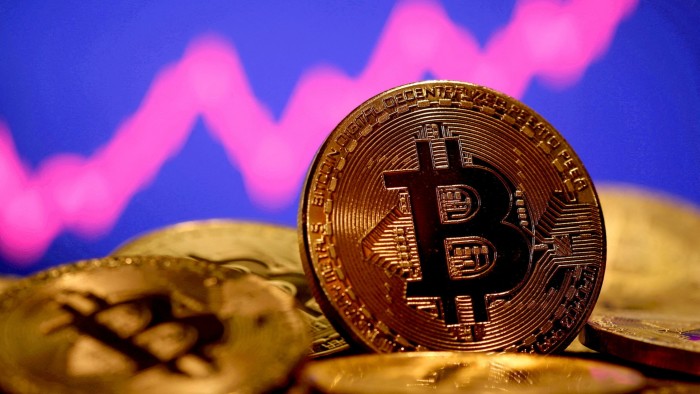Grayscale aims for possible loophole with new bitcoin ETF filing

Simply sign up to the Exchange traded funds myFT Digest -- delivered directly to your inbox.
Latest news on ETFs
Visit our ETF Hub to find out more and to explore our in-depth data and comparison tools
Grayscale, manager of the world’s largest cryptocurrency fund, has long been stymied by regulators in its bid to convert its flagship vehicle into an exchange traded fund.
However, it may have found a ruse to partially circumvent the restrictions imposed by the US Securities and Exchange commission.
Grayscale has filed to launch a US-listed ETF that would partly invest in so-called “spot” bitcoin exchange traded products already up and running in other countries.
These ETPs invest directly in “physical” bitcoin, or track the cryptocurrency’s price synthetically — structures the SEC has so far not permitted.
Instead, the SEC has only allowed bitcoin ETFs that trade in futures contracts listed on the Chicago Mercantile Exchange, which is a regulated venue.
This stance has prompted Grayscale to sue the SEC for its refusal to allow the $16.9bn Grayscale Bitcoin Trust (GBTC), a private spot bitcoin trust, to convert to an ETF. A ruling is due by the end of the third quarter.
In the interim, though, Grayscale has filed to launch a Global Bitcoin Composite ETF, which would invest 40 per cent of its assets in spot bitcoin ETPs listed on “major non-US exchanges”, such as in Canada or Europe.
While there is no guarantee that the application will be approved, analysts believe it has a chance given that the overseas ETPs Grayscale is proposing to invest in are regulated securities — precisely the type of asset that the SEC has insisted crypto ETFs hold.
“Grayscale’s filing seems intended to push the envelope with the SEC by using the SEC’s own words against it to launch crypto ETFs,” said Bryan Armour, director of passive strategies research, North America at Morningstar.
“This seems like Grayscale is directly challenging the SEC’s past decision to allow bitcoin futures ETFs on one hand and on the other hand reject spot bitcoin ETFs,” he added.
Todd Rosenbluth, head of research at VettaFi, a consultancy, described the filing “as a creative way of Grayscale trying to offer US-listed product with some spot bitcoin exposure”.
“I think there is greater likelihood of Grayscale getting approval for this ETF than it getting the SEC to voluntarily approve a US-listed spot bitcoin only ETF, which is what Grayscale wants,” he added.
Rosenbluth believed the filing was an “acceptance of the reality that the SEC is not going to give [Grayscale] the green light”, to convert GBTC.
One point in Grayscale’s favour in its latest filing is that vast numbers of US-listed ETFs already hold regulated, non-US securities, mostly in the form of equities and bonds.
Indeed, at least one US ETF already holds foreign-listed spot bitcoin ETFs, appearing to set something of a precedent for the structure.
The $447mn Amplify Transformational Data Sharing ETF (BLOK) has positions in four Toronto-listed spot bitcoin ETFs, although they currently account for just 4.3 per cent of its portfolio, with the balance in stocks of companies involved in blockchain technology.
Grayscale is proposing that its 40 per cent exposure to spot bitcoin ETFs would be weighted equally between five underlying funds.
Rosenbluth also noted the “added irony” of Cathie Wood’s Ark Next Generation Internet ETF (ARKW) having a 6.8 per cent exposure to Grayscale’s GBTC trust, even though the SEC deems GBTC’s structure to be unsuitable for an ETF. The SEC declined to comment.
Even if Grayscale was to get approval for the Global Bitcoin Composite ETF, it is far from certain there would be a huge appetite for the fund, however.
It is proposing that the remaining 60 per cent of the portfolio would be invested in the equity of bitcoin mining companies. Armour was unconvinced there was much demand for such a structure.
“I don’t think investors benefit from access to a 60/40 portfolio of bitcoin miners and a global spot bitcoin fund of funds sleeve,” he said.
“The portfolio is confusing and will do a worse job tracking the spot bitcoin price than a bitcoin futures ETF, so I’m not sure this type of product adds any value aside from parsing out the SEC’s strategy for approving bitcoin-related ETFs.”
Rosenbluth agreed demand might be lacking, saying “combining bitcoin with other investments is not novel but has had limited interest”.
As evidence he cited the Global X Blockchain & Bitcoin Strategy ETF (BITS), which invests in the Global X Blockchain ETF (BKCH) and bitcoin futures, but which holds just $11mn.
Rosenbluth noted that despite a strong bounce for bitcoin and crypto-related companies after last year’s sharp losses, with the currency itself up 61 per cent so far this year, “demand for ETFs exposed to bitcoin has been limited”.
Latest news on ETFs

Visit the ETF Hub to find out more and to explore our in-depth data and comparison tools helping you to understand everything from performance to ESG ratings
“Investors seem sceptical the rally can persist and remember the challenges of 2022,” he added.
For instance, although the $1bn ProShares Bitcoin Strategy ETF (BITO), the largest bitcoin futures ETF, was up 57 per cent year to date as of May 12, it had only seen net inflows of $95mn, according to VettaFI’s data. This was not far ahead of the $75mn attracted by the $120mn ProShares Short Bitcoin ETF Strategy (BITI), which takes the opposite bet and is down 44 per cent year to date.
BKCH has returned 69 per cent so far this year but has seen net outflows of $2mn. Likewise the Invesco Alerian Galaxy Crypto Economy ETF (SATO) is up 68 per cent “and has seen no investor interest either”, Rosenbluth added.
Michael Sonnenshein, chief executive of Grayscale, was more bullish, however, arguing that “there is no question, coming out of the crypto winter, that investors’ appetite for crypto remains healthy. It has certainly not gone unnoticed by the crypto community that crypto has achieved some of the highest returns in 2023 to date.”
Comments